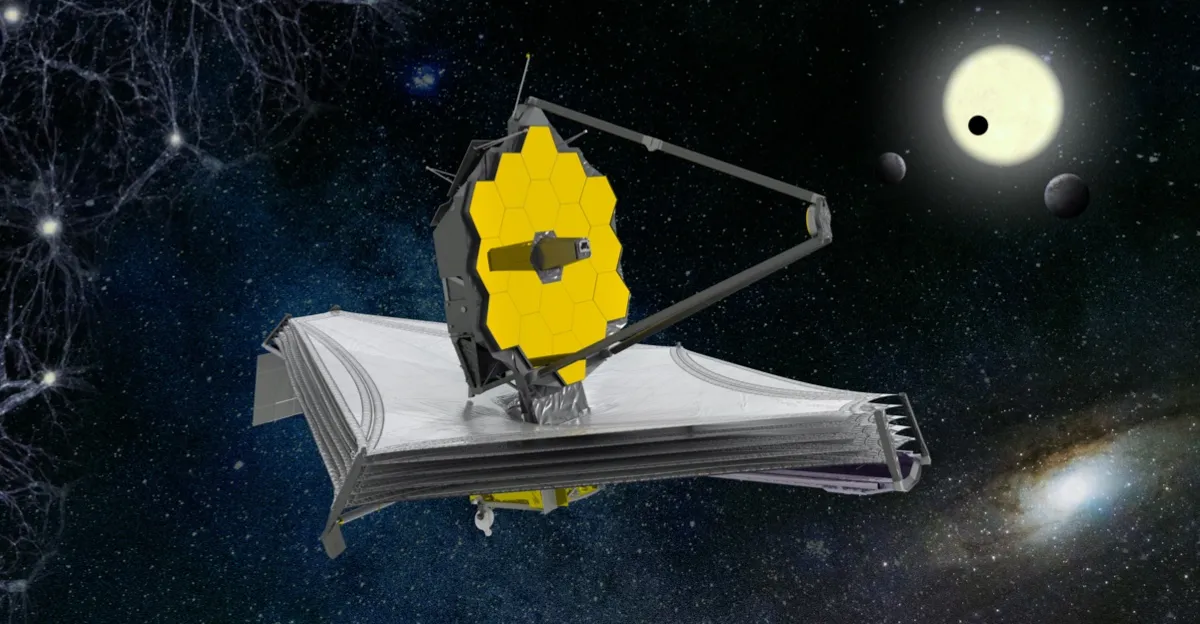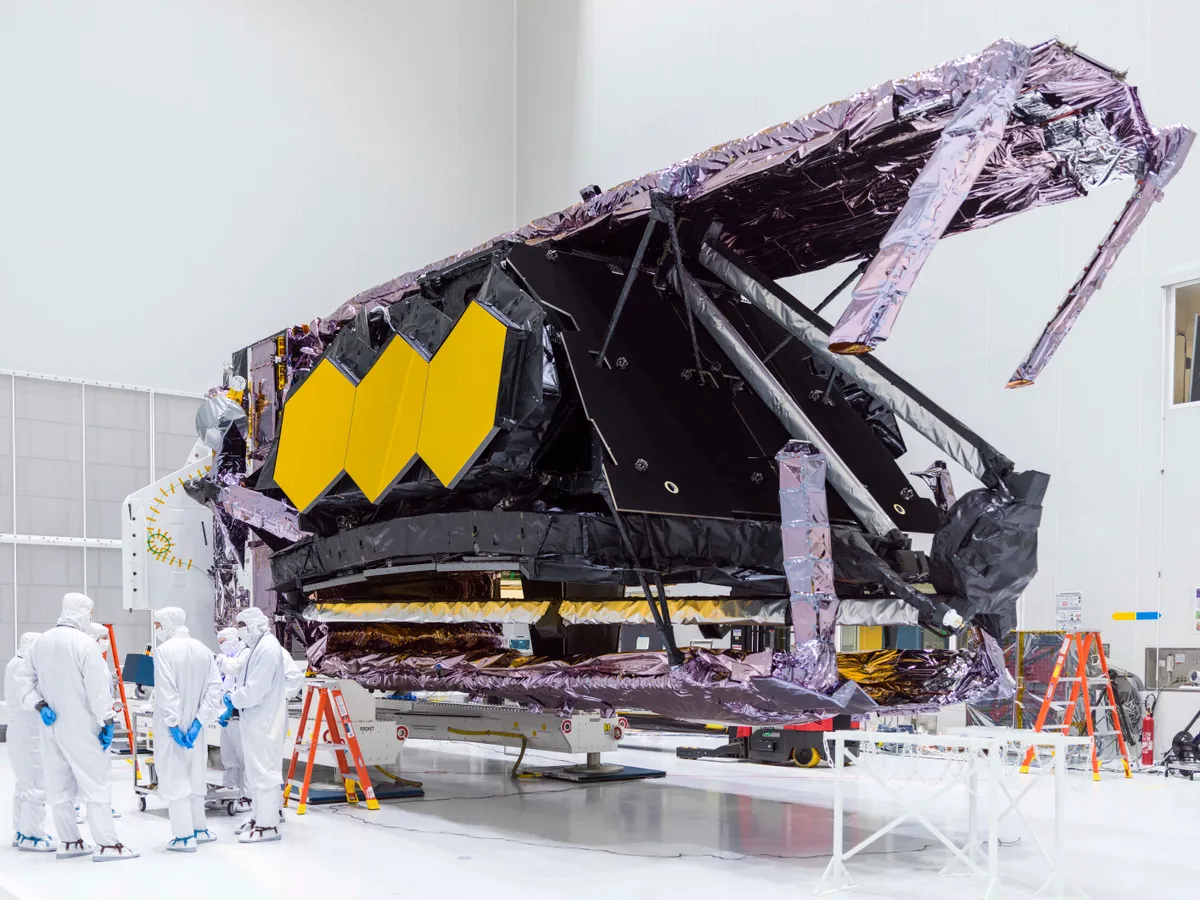You may be tempted to think of the James Webb Space Telescope as just another hyped-up space mission. Resist that urge. The James Webb Space Telescope is genuinely the most ambitious space telescope or probe ever launched. It is also the biggest gamble.
The JWST, or Webb as NASA would like it to be known, is designed to reveal the evolution of the Universe from its early phases to the modern era. It will do this by undertaking a thorough investigation of the Universe at infra-red wavelengths.
To reveal the evolution of the Universe, it will target the origin of the various celestial objects that have emerged along the way. This begins in the far distant, early Universe when Webb’s cameras and instruments will focus on the first galaxies and the first stars to light up the Universe.
Today, the evidence suggests that probably every galaxy contains a supermassive black hole at its centre. Yet, how those black holes form is a mystery. Were they the gravitational seeds that catalysed galaxy formation or did they form naturally at the centre of a gigantic gas cloud that was already coalescing to become a galaxy. Webb will investigate.

As for the first stars, no one knows what these were like but theory suggests they could be gigantic megastars, burning more brightly and hotter than anything in the Universe today. Webb will search for them.
It will also scrutinise the birth of stars and planets in the more recent Universe by peering inside the dusty nebulae that cocoon these nascent celestial objects.
Infrared is uniquely suited to all of these studies. In the case of the first stars and galaxies, they are so far away that the Universe has expanded greatly since their light began its journey. This has stretched their light, transformed what was once visible light into infrared light.
Read more about space exploration:
- Space exploration: how might the next 50 years progress?
- Elisa Raffaella Ferrè: What happens to the brain in space?
- Move over, Mars: why we should look further afield for future human colonies
As far as looking inside the birth clouds of stars and planets, infrared light is much more penetrating than visible light, and so will allow astronomers to see more deeply inside.
Another big reason for using infrared is that molecules are particularly interactive at those wavelengths. Hence, studying the infrared light reflected by celestial objects, or being emitted by them, allows the molecular composition of those objects to be studied. While the chemistry of a celestial object is interesting in its own right, these studies can also be used to gauge the habitability of planets. This is because chemistry is the essential stepping stone from physics to biology.
Particular targets for Webb’s molecular analysis include some of the thousands of planets that have been discovered around other stars. Webb will also become a powerful tool for analysing the ices on distant bodies in our own Solar System that may hold secrets dating back to the formation of our own Solar System.
Webb’s science goals have been built from the questions that the Hubble Space Telescope has revealed to us. This is why Webb is often said to be the successor of the Hubble, even though it operates at very different wavelengths.

In the same way that Hubble revolutionised our view of the Universe and changed so many things about our understanding of the celestial objects, so Webb is hoped to do the same. It is a huge general purpose observatory, stationed 1.5 million kilometres away in space. It will take a month to cruise to its final orbit, and has been designed to last for at least 10 years.
As Hubble did, Webb will open a new window on our Universe. Every time you do that, history tells us that the potential for discovery is enormous. So put all those things together and we could be on the verge of a great watershed in our understanding of the Universe.
But it is a massive gamble because Webb cannot be launched in its finished configuration. When operational, Webb is the size of a tennis court. Most of that is made up of the sun shield because to work at the infrared wavelengths that astronomers are targeting, the telescope must be shielded from the Sun’s heat. This sunshield is made of five layers of high-tech material that must be rolled together and folded away during launch, then pulled outwards with a complex system of moving platforms, and deployable boom arms.
Read more about the Solar System:
- 20 of the most amazing moons in the Solar System
- What asteroids can tell us about our Solar System – Natalie Starkey
- Did a ‘wrecking ball’ Jupiter smash up our early Solar System?
Then there is the telescope mirror itself. Webb’s primary mirror is 6.5 metres in diameter, compared to the 2.4 metres of Hubble, and it is too large to fit into the fairing of the launch vehicle, so like the sun shield, it has to be folded. How do you fold a mirror? Simple, you make it out of gold hexagonal segments and fit some of those with motors so that they flap backwards out of the way.
It sounds impressive – indeed, it is impressive. But only if it works. The engineering challenge of building an unfolding telescope is unparalleled. This is one of the principal reasons that the telescope has taken a quarter of a century to develop and cost roughly $10bn to make.
And that’s what makes it all such a gamble. This telescope has absorbed so much time, effort and money that it is ‘too big to fail’. In fact, it crossed that line years ago, which is how it unlocked more and more cash to overcome the substantial technological hurdles that it continued to encounter. And as more money was invested, so the pressure to get it right became greater and greater – which led to more tests and more delays and more money and more pressure and so on. Now comes the moment of truth for this mission.

On 22 December, the Webb will be carried into space by a European Ariane 5 rocket. Once en route to its destination, ground operators will deploy each part of the telescope in a series of steps. It will take weeks, and at each step in that process something could go wrong. That is, of course, not to say that it will go wrong, but it must be the single biggest fear in the minds of everyone associated with the project.
When you watch it launch, wish the Webb well but remember that’s not the end of it. As Han Solo said following a similarity dicey launch from Tatooine, “Here’s where the fun begins.”
So check in regularly in the days and weeks following the launch to find out how the deployment is going. By the end of January, Webb should be fully deployed and in its operating orbit. Then, in your best Harrison Ford voice, you can say, “Here’s where the science begins.”